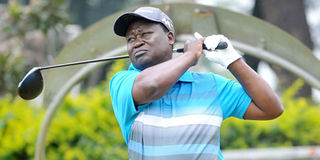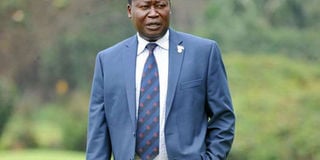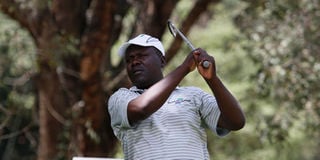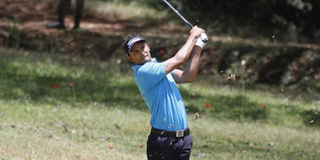KGU boss Wanjalla’s big dreams for golf in Kenya

Kenya Golf Union Chairman Richard Wanjalla follows the progress of his shot at Muthaiga Golf Club Practice range on May 31, 2017. PHOTO | CHRIS OMOLLO |
What you need to know:
- Newly-elected chairman of Kenya Golf Union, Richard Wanjalla, has big dreams for golf in Kenya.
- Wanjalla, who took over KGU’s leadership from from Muchau Githiaka of Vet Lab Sports Club during the union’s Annual General Meeting at Muthaiga Golf Club last month, is disturbed by the fact that each year Kenya makes a large entry of professionals and amateurs in the Kenya Open but the performance remains below par.
- He says there is urgent need for the Kenya Open Golf Limited (KOGL), Professional Golfers of Kenya (PGK), KGU and other stakeholders to review team selection, team preparation and any other support that can result in improved performance to enable more Kenyans to not only make the cut but also aim at the top prize.
Newly-elected chairman of Kenya Golf Union, Richard Wanjalla, has big dreams for golf in Kenya.
Wanjalla, who took over KGU’s leadership from from Muchau Githiaka of Vet Lab Sports Club during the union’s Annual General Meeting at Muthaiga Golf Club last month, is disturbed by the fact that each year Kenya makes a large entry of professionals and amateurs in the Kenya Open but the performance remains below par.
He says there is urgent need for the Kenya Open Golf Limited (KOGL), Professional Golfers of Kenya (PGK), KGU and other stakeholders to review team selection, team preparation and any other support that can result in improved performance to enable more Kenyans to not only make the cut but also aim at the top prize.
Wanjalla plans to set up golf schools or academies in all the counties to not only spread the game widely but to also help nurture talent.
“We will establish a vehicle to be called Kenya Golf Academies under whose umbrella we’ll lobby the national government and county governments to set aside land for building of 47 schools which will be fully equipped with a golf club, and other facilities that fully comply with Kenya Primary Schools Curriculum. This is in line with the objectives of Junior Golf Foundation. This will be a more effective way of developing juniors to meet our long term aspirations of making Kenya a strong golfing nation. The current out-put from JGF is too little too late,” he says.

Kenya Golf Union Chairman Richard Wanjalla takes a walk at the Muthaiga Golf Club Practice range on May 31, 2017. PHOTO | CHRIS OMOLLO |
“With these Academies, we will be able to pick kids from Class One to Class Five, teach them golf and give them normal education at the same time,’’ says Wanjalla. “My Team will seek to strengthen our working relationships with the Government through the Ministry of Sports and other Ministries. This will enable us to advance the Lenana school project and also revive the Kasarani project and to also undertake new projects. Sports Kenya, through its chairman Fred Muteti, is already working closely with us as it has financially helped KGU to send Team Kenya golfers to various overseas and regional engagements.’’
But the new KGU boss would like more support from Sports Kenya and other government agencies. The Golf Talent Foundation of Kenya was incorporated on October 12, 2004, 13 years since its inception.
“We need to re-engineer our approach to acquiring and nurturing talent. We do not have to re-invent the wheel. We can do more as individuals. This foundation should take an example of Nairobi Governor Evans Kidero who adopted and mentored Dismas Indiza who has consistently made a stab at the Kenya Open,” he says.

Kenya's Dismas Indiza follows the progress of his shot from the first tee during the third round of the Barclays Kenya Open at Muthaiga Golf Club on March 25, 2017. PHOTO | MARTIN MUKANGU |
“We cannot build talent from golfers who do not have a support base backed with employment (career), and other basic necessities in life. How can a young upcoming talented golfer go on to conquer the world in golf if he has to operate on empty stomach and perhaps no shelter?
“Most Kenyan athletes who bring honour to the land by breaking world records are largely employees of the disciplined forces or in industry. The same should apply to golf.’’
Wanjalla says Kenya Open Golf Limited (KOGL) has put Kenya on the world’s golfing map by consistently holding the Kenya Open annually in collaboration with the European Challenge Tour and our corporate sponsors, Barclays Bank being the current main sponsor.
‘‘We thank Barclays and other sponsors such as Nation Media Group who are putting in their resources to sustain this popular tournament. As we may all recall, President Uhuru Kenyatta pledged to upgrade the Kenya Open prize money to one million dollars in next year’s tournament. As KGU, KOGL and PGK and the entire golfing fraternity, we thank him for this big support. In the same breathe however we should challenge ourselves to up our game and ensure that Kenya golfers fight hard to earn a sizeable slice of the prize money.’’
On club memberships, Wanjalla says currently Kenya has 40 active golf clubs out of the 42 listed affiliate clubs. Out of these clubs, eight have less than 25 handicapped golfers, nine clubs each have less than 50 while seven clubs have less than 100 and only 12 clubs have over 200 handicapped golfers.

Golfer Stefan Andersen of Kenya putts on his way to a second place finish at the Vodacom Origins of Golf tournament in Arabella, Western Cape, South Africa, in August 2016. PHOTO | FILE |
But there is still room for improvement, going by the numbers. In all, the total number of handicapped male golfers stands at 5,762. These, compared to countries such as South Africa which has 160,000 golfers out of which 116,800 come from 466 clubs in the 14 provincial unions affiliated to South Africa Golf Association (SAGA).
“With such a large number of affiliated golfers, SAGA is able to develop the game very easily in collaboration with corporate sponsorship. My wish therefore is that KGU should engage various clubs and undertake a countrywide recruitment to reach 10,000 men golfers on the CONGU handicap system. This is not only an important source of revenue but it will also lead to a big transformation. Other countries like South Africa have a large pool of golfers at all levels,” he says.
Wanjalla reckons that since October 2, 1995 when the Junior Golf Foundation (JGF) was established, Kenya has achieved very little as far as creating world-class golf professionals is concerned, 22 years down the line.

Greg Snow follows his shot during the Barclays Kenya Open at Muthaiga Golf Club on March 23, 2017. PHOTO | MARTIN MUKANGU |
Such players like Stefan Andersen and Greg Snow who emerged through the junior ranks have reached the levels of success they have attained at the moment largely through the effort of their parents.
“We should take stock of our success and re-energise ourselves to pursue JGF’s objectives more vigorously by taking other stakeholders on board. JGF should harness the goodwill it enjoys from government.”
Wanjalla also paid tribute to past KGU chairmen in the last decade and singled out Francis Okwara who opened communication channels between the union and the Sports Ministry and other government departments.





